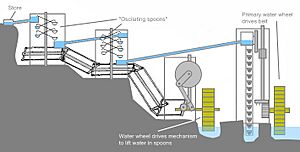Artificio de Juanelo facts for kids
The Artificio de Juanelo ("Gianello's artifice") was the name of two amazing machines built in Toledo, Spain, in the 1500s. They were created by a brilliant inventor named Juanelo Turriano. These machines were designed to bring water from the Tagus (Tajo) river up to the city and the Alcázar palace. At the time, they were seen as incredible engineering achievements. Today, they are in ruins, and we don't know exactly how they worked.
History of the Water Machines
Juanelo Turriano was an Italian-Spanish clock maker, engineer, and mathematician. He came to Spain in 1529. The Holy Roman Emperor, Charles V, made him his official Court Clock Master. By 1534, Turriano was working in Toledo, which was then the capital of the Spanish Empire.
Toledo had a big problem: it needed water! The old Roman water system was broken. A huge water wheel built by the Moors long ago was also destroyed. People tried different ways to get water, but nothing worked well. When Turriano arrived, people used donkeys to carry pitchers of water from the river up to the city. This was a hard trip, climbing about 100 meters (330 feet) over bumpy ground. It was not a good way to get enough water for everyone.
After some time in Toledo, a nobleman named Alfonso de Avalos challenged Turriano. He asked Turriano to find a way to bring water from the Tagus river to the city. Turriano drew up detailed plans for a machine. However, building it was difficult. There were many delays and problems, including the death of Emperor Charles V in 1558.
Charles V's son, Philip II, was not as interested in engineering. Turriano was not as famous under Philip as he had been under Charles. Still, Philip knew Turriano was valuable. He called him "Matemático Mayor" (Chief Mathematician) and gave him other engineering jobs.
It seemed like the water-lifting project might be stopped at times. But by 1565, Turriano managed to take charge of the project again. He made a deal with the city council. He promised to deliver 1,600 pitchers of water every day to the city within three years. This was about 12,400 liters (3,275 US gallons) daily.
We don't know the exact date the machine started working. But by 1568, it was delivering even more water than promised. It brought about 14,100 liters (3,725 US gallons) a day! However, the city refused to pay Turriano the agreed price. They said the water was stored at the Alcázar palace, so it was only for the royal family, not the whole town.
Turriano was frustrated because the council would not pay him. He was also in debt from building the machine. So, he made another agreement, supported by the King. He would build a second machine to supply the city. This time, he and his family would own the rights to run it.
The second machine was finished in 1581. The King paid for its construction. But Turriano could not afford the costs of keeping it running. He had to give control of the machine to the city. He died soon after, in 1585.
The machines kept working until about 1639. Then, parts were stolen, and they were not taken care of. Both machines fell apart. The first machine was taken apart. The second one was left standing as a symbol of the city. But it stopped working. Water had to be carried by donkeys again. More parts were stolen from the second machine, and now very little of it remains.
How the Machines Worked
The Artificio de Juanelo caused a big stir because it lifted water higher than ever before. It raised water more than twice the height of any previous machine. Before this, the highest water lift was about 40 meters (130 feet) in Augsburg, using a different type of machine called an Archimedes' screw.
We don't know all the exact details of how the Artificio was built. But the most popular idea comes from Ladislao Reti. He based his ideas on old descriptions.
Here's how it might have worked:
- A large water wheel powered a moving belt.
- This belt had buckets or large jars (called amphora) attached to it.
- The buckets carried water to the top of a tall tower.
- At the top, the buckets would tip over, pouring water into a small tank.
- From this tank, the water flowed down a pipe to a smaller tower.
- A second water wheel provided power to pumps inside this second tower.
- These pumps moved a series of cups attached to arms.
- The arms of the cups were hollow. They had an opening that let water flow down inside the arm and out the other end.
- The arms moved up and down like a see-saw, lifting the water to higher and higher levels in the cups.
- Once the water reached the highest level in this tower, it flowed down another pipe to a third tower.
- This third tower also had cups on arms, powered by the second water wheel.
- This final tower lifted the water high enough for it to flow into the storage tanks at the Alcázar palace.
See also
 In Spanish: Artificio de Juanelo para niños
In Spanish: Artificio de Juanelo para niños



